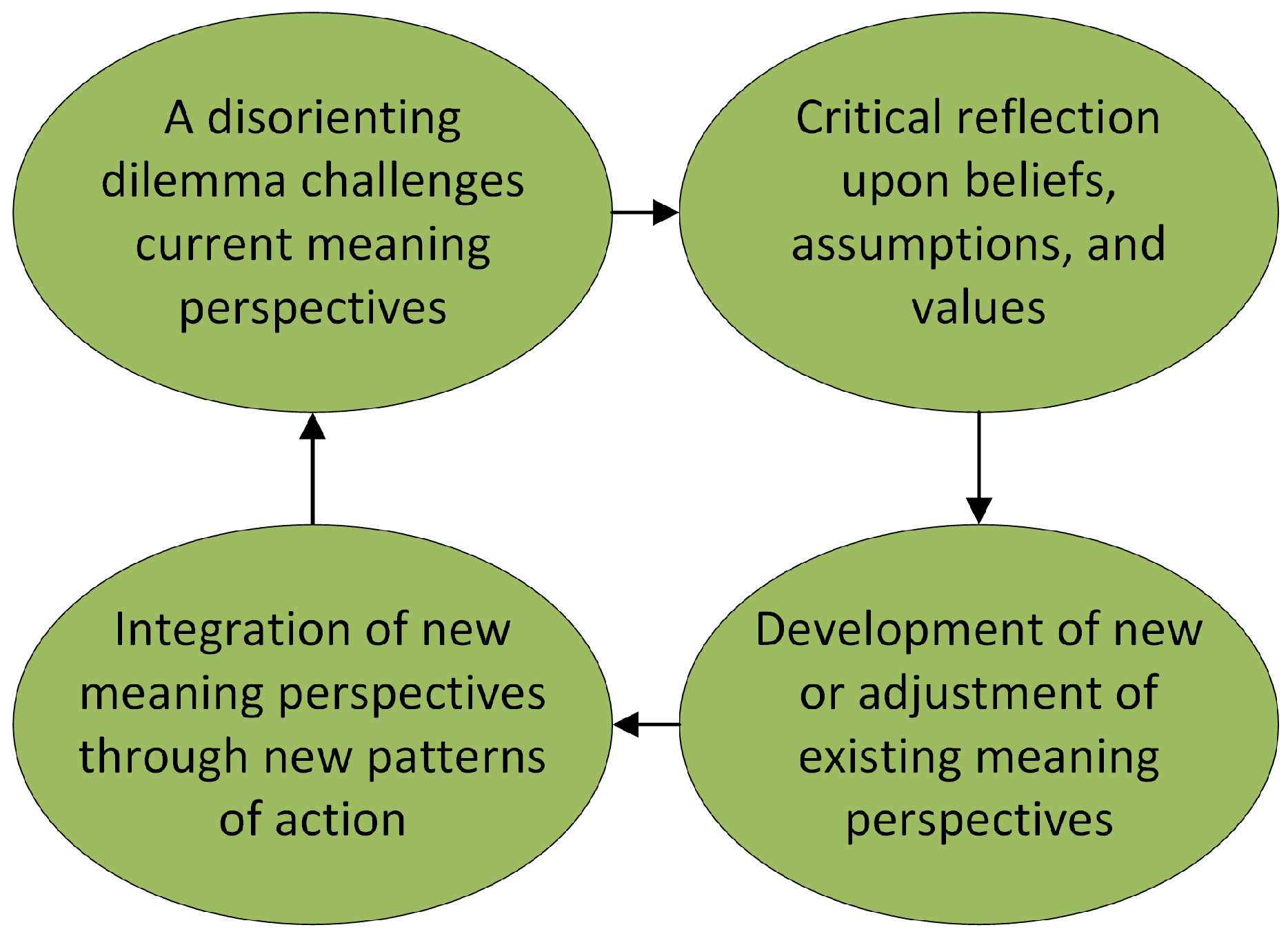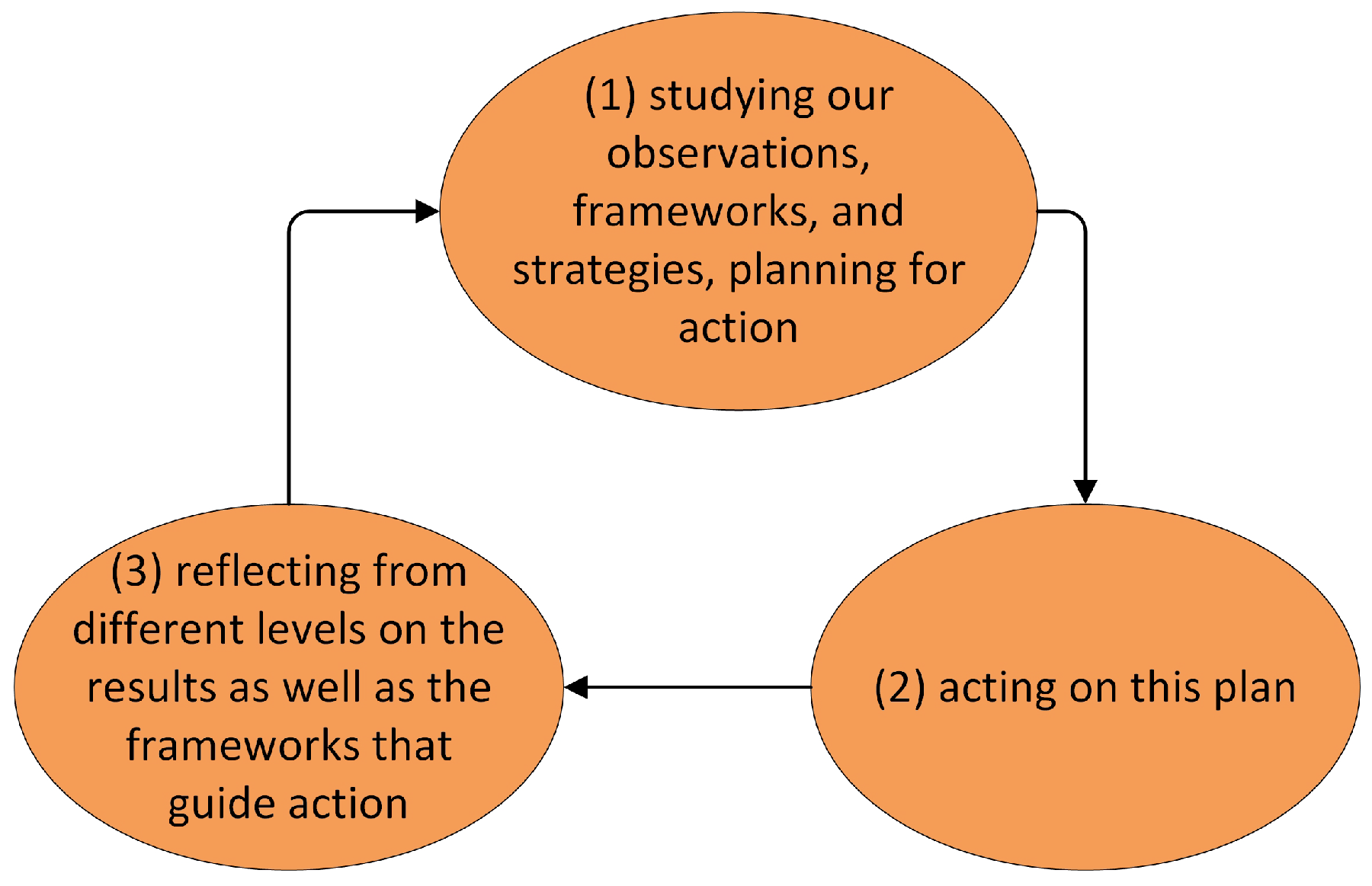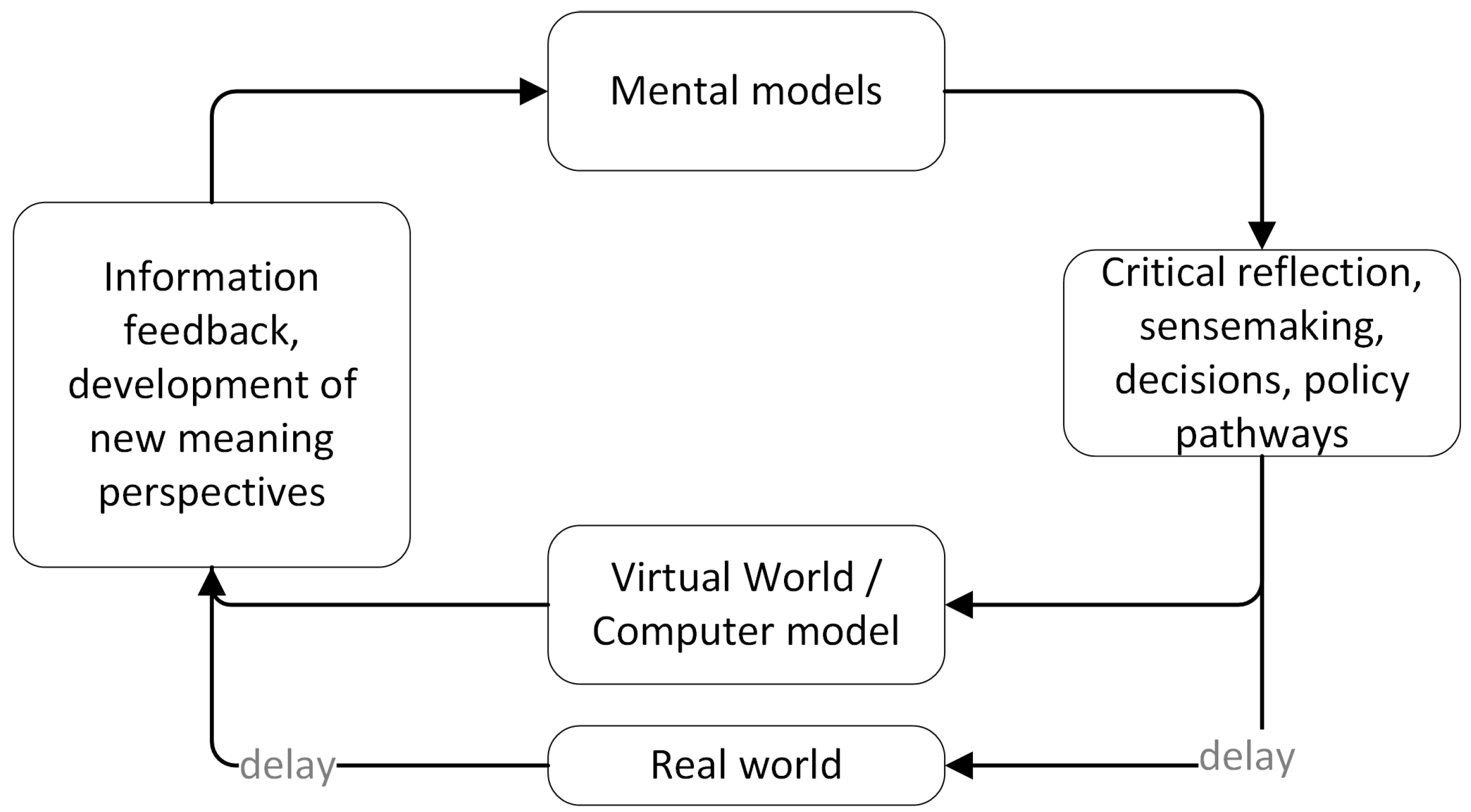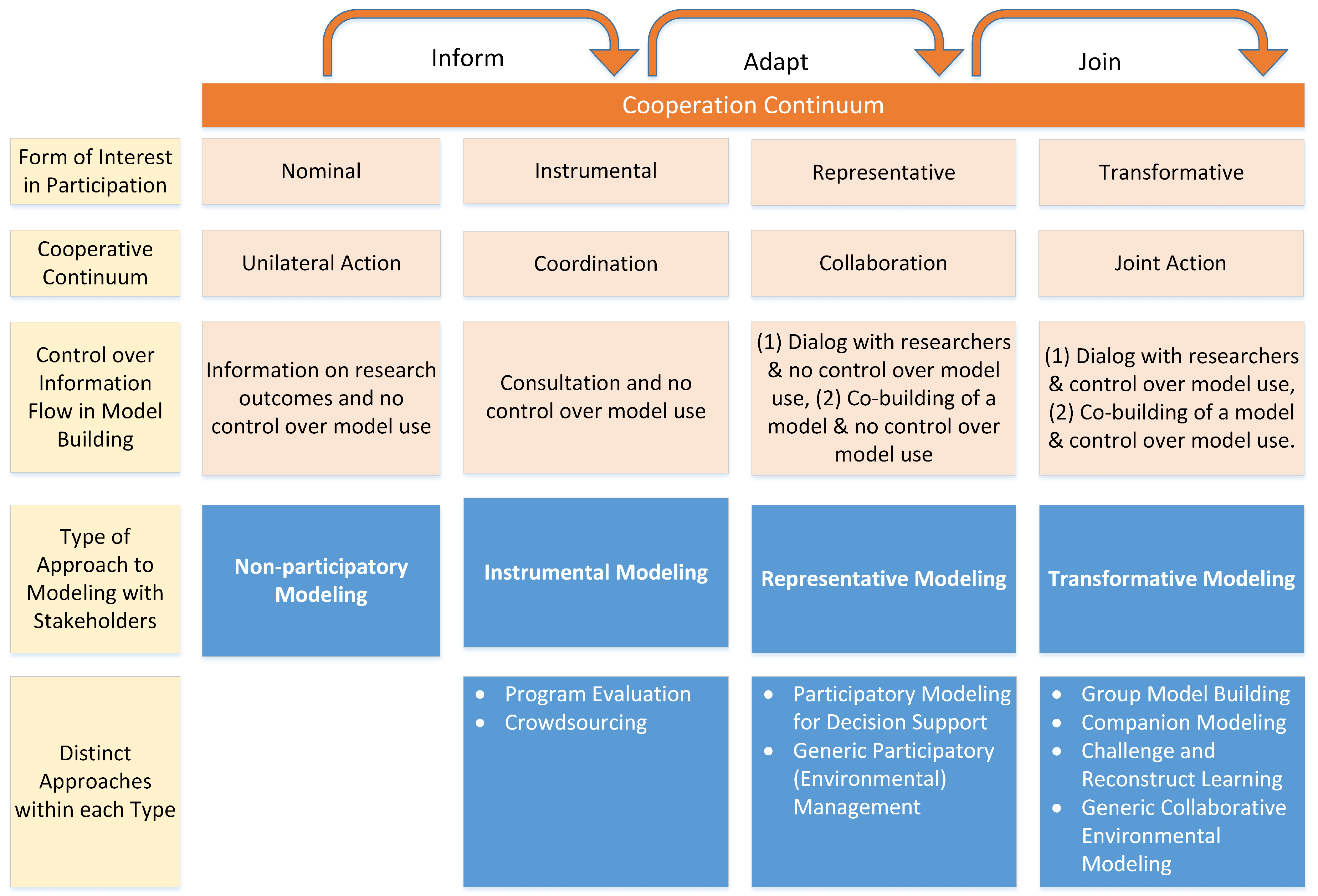Modeling with Stakeholders for Transformative Change
Abstract
:1. Introduction
- scientific incentives and the not made here syndrome.
- disciplinary biases.
- fragmentation of research efforts across disciplines, academic societies and conferences, and journals.
- the ’incoherency problem’ in the social sciences.
2. Role of Models in Transformative Change
2.1. Transformative Change
2.2. Role of Simulation Models
3. Typology of Approaches to Modeling with Stakeholders
3.1. Continuum of Forms of Participation in Modeling
3.1.1. Interest in Participation
3.1.2. Control over Information Flow
3.1.3. Role of Participation in Transformative Processes
3.2. Four Approaches to Modeling for Transformative Change
- Group model building
- Companion modeling
- Challenge-and-Reconstruct Learning
- Generic collaborative (environmental) modeling
4. Comparing Approaches to Modeling for Transformative Change
- the knowledge elicitation tools
- the types of models
- posture of the facilitator and power balance
- guidance, standards, and templates
- reporting
5. Developing Transformative Participatory Modeling Processes
6. Conclusions
Author Contributions
Funding
Acknowledgments
Conflicts of Interest
References
- Pelling, M.; O’Brien, K.; Matyas, D. Adaptation and transformation. Clim. Chang. 2015, 133, 113–127. [Google Scholar] [CrossRef]
- Haasnoot, M.; Middelkoop, H.; Offermans, A.; van Beek, E.; van Deursen, W. Exploring pathways for sustainable water management in river deltas in a changing environment. Clim. Chang. 2012, 115, 795–819. [Google Scholar] [CrossRef]
- Kwakkel, J.H.; Haasnoot, M.; Walker, W.E. Developing dynamic adaptive policy pathways: A computer-assisted approach for developing adaptive strategies for a deeply uncertain world. Clim. Chang. 2015, 132, 373–386. [Google Scholar] [CrossRef]
- Wise, R.; Fazey, I.; Stafford Smith, M.; Park, S.; Eakin, H.; Archer van Garderen, E.; Campbell, B. Reconceptualizing adaptation to climate change as part of pathways of change and response. Glob. Environ. Chang. 2014, 28, 325–336. [Google Scholar] [CrossRef]
- Colander, D.; Kupers, R. Complexity and the Art of Public Policy: Solving Society’s Problems from the Bottom Up; Princeton University Press: Princeton, NJ, USA, 2014; p. 320. [Google Scholar]
- Sterman, J.D. Learning in and about complex systems. Syst. Dyn. Rev. 1994, 10, 291–330. [Google Scholar] [CrossRef]
- Frigg, R.; Hartmann, S. Models in Science. In The Stanford Encyclopedia of Philosophy (Summer 2018 Edition); Zalta, E.N., Ed.; Metaphysics Research Lab, Stanford University: Stanford, CA, USA, 2018; Available online: https://plato.stanford.edu/archives/sum2018/entries/models-science/ (accessed on 23 July 2018).
- Pool, R. The third branch of science debuts. Science 1992, 256, 44. [Google Scholar]
- Black, L.J.; Andersen, D.F. Using Visual Representations as Boundary Objects to Resolve Conflict in Collaborative Model-Building Approaches. Syst. Res. Behav. Sci. 2012, 29, 194–208. [Google Scholar] [CrossRef]
- Star, S.L.; Griesemer, J.R. Institutional Ecology, ‘Translations’ and Boundary Objects: Amateurs and Professionals in Berkeley’s Museum of Vertebrate Zoology, 1907–39. Soc. Stud. Sci. 1989, 19, 387–420. [Google Scholar] [CrossRef]
- Kwakkel, J.H.; Walker, W.E.; Marchau, V. From Predictive Modeling to Exploratory Modeling: How to use Non- Predictive Models for Decisionmaking under Deep Uncertainty. In Proceedings of the 25th Mini-EURO Conference on Uncertainty and Robustness in Planning and Decision Making (URPDM2010), University of Coimbra, Portugal, 15–17 April 2010. [Google Scholar]
- Holtz, G.; Alkemade, F.; De Haan, F.; Köhler, J.; Trutnevyte, E.; Luthe, T.; Halbe, J.; Papachristos, G.; Chappin, E.J.L.; Kwakkel, J.H.; et al. Prospects of modelling societal transitions: Position paper of an emerging community. Environ. Innov. Soc. Transit. 2015, 17, 41–58. [Google Scholar] [CrossRef]
- Pilkey-Jarvis, L.; Pilkey, O.H. Useless Arithmetic: Ten Points to Ponder When Using Mathematical Models in Environmental Decision Making. Public Adm. Rev. 2008, 68, 470–479. [Google Scholar] [CrossRef]
- Morris, N. A Comparative Analysis of the Diffusion and Participatory Models in Development Communication. In Media and Glocal Change. Rethinking Communication for Development; Consejo Latinoamericano de Ciencias Sociales: Buenos Aires, Argentina, 2003; pp. 123–144. [Google Scholar] [CrossRef]
- Popa, F.; Guillermin, M.; Dedeurwaerdere, T. A pragmatist approach to transdisciplinarity in sustainability research: From complex systems theory to reflexive science. Futures 2015, 65, 45–56. [Google Scholar] [CrossRef]
- Voinov, A.A.; Bousquet, F. Modelling with stakeholders. Environ. Model. Softw. 2010, 25, 1268–1281. [Google Scholar] [CrossRef]
- Döll, P.; Romero-Lankao, P. How to embrace uncertainty in participatory climate change risk management—A roadmap. Earth’s Future 2017, 5, 18–36. [Google Scholar] [CrossRef]
- Voinov, A.A.; Kolagani, N.; McCall, M.K.; Glynn, P.D.; Kragt, M.E.; Ostermann, F.O.; Pierce, S.A.; Ramu, P. Modelling with stakeholders—Next generation. Environ. Model. Softw. 2016, 77, 196–220. [Google Scholar] [CrossRef]
- Voinov, A.A.; Hewitt, R.; Jiménez, V.H.; Boer, C.D.; Svedin, U.; Borga, M.; Filatova, T.; Saeed, M.; Winder, N.; Report, D.; et al. A Generic Framework for Participatory Modelling with Use Cases from the Project’s WPs; Technical Report, Knowledge Based Climate Mitigation Systems for a Low Carbon Economy FP7 EU Project; University of Newcastle: Newcastle, UK, 2016. [Google Scholar]
- Watts, D.J. Should social science be more solution-oriented? Nat. Hum. Behav. 2017, 1, 0015. [Google Scholar] [CrossRef]
- Haasnoot, M.; van Deursen, W.P.A.; Guillaume, J.H.A.; Kwakkel, J.H.; van Beek, E.; Middelkoop, H. Fit for purpose? Building and evaluating a fast, integrated model for exploring water policy pathways. Environ. Model. Softw. 2014, 60, 99–120. [Google Scholar] [CrossRef]
- Trindade, B.; Reed, P.; Herman, J.; Zeff, H.; Characklis, G. Reducing regional drought vulnerabilities and multi-city robustness conflicts using many-objective optimization under deep uncertainty. Adv. Water Resour. 2017, 104, 195–209. [Google Scholar] [CrossRef]
- Kwakkel, J.; Haasnoot, M.; Walker, W. Comparing Robust Decision-Making and Dynamic Adaptive Policy Pathways for Model-Based Decision Support under Deep Uncertainty. Environ. Model. Softw. 2016, 86, 168–183. [Google Scholar] [CrossRef]
- Zeff, H.; Herman, J.; Reed, P.M.; Characklis, G. Cooperative drought adaptation: Integrating infrastructure development, conservation, and water transfers into adaptive policy pathways. Water Resour. Res. 2016, 52, 7327–7346. [Google Scholar] [CrossRef]
- Smith, R.; Kasprzyk, J.; Dilling, L. Participatory Framework for Assessment and Improvement of Tools (ParFAIT): Increasing the impact and relevance of water management decision support research. Environ. Model. Softw. 2017, 95, 432–446. [Google Scholar] [CrossRef]
- NRC. Informing Decisions in a Changing Climate; National Academy Press: Washington, DC, USA, 2009.
- O’Brien, K. Global environmental change II: From adaptation to deliberate transformation. Prog. Hum. Geogr. 2012, 36, 667–676. [Google Scholar] [CrossRef]
- Kitchenham, A. The Evolution of John Mezirow’s Transformative Learning Theory. J. Transform. Educ. 2008, 6, 104–123. [Google Scholar] [CrossRef]
- Mezirow, J. How Critical Reflection Triggers Transformative Learning. In Fostering Critical Reflection in Adulthood: A Guide to Transformative and Emancipatory Learning; Jossey-Bass: San Francisco, CA, USA, 1990; pp. 1–18. [Google Scholar]
- Mezirow, J. Transformative Learning: Theory to Practice Transformative Learning Theory. In Transformative Learning (Mezirow); Jossey-Bass: San Francisco, CA, USA, 1997; pp. 5–12. [Google Scholar]
- Mezirow, J. A critical theory of self-directed learning. New Dir. Cont. Educ. 1985, 1985, 17–30. [Google Scholar] [CrossRef]
- Mezirow, J. Understanding Transformation Theory. Adult Educ. Q. 1994, 44, 222–232. [Google Scholar] [CrossRef]
- Mezirow, J. A Critical Theory of Adult Learning and Education. Adult Educ. 1981, 32, 3–24. [Google Scholar] [CrossRef]
- Spekkink, W.A.H.; Boons, F. The Emergence of Collaborations. J. Public Adm. Res. Theory 2015, 26, 613–630. [Google Scholar] [CrossRef]
- Voinov, A.A.; Kolagani, N.; McCall, M.K. Preface to this Virtual Thematic Issue: Modelling with Stakeholders II. Environ. Model. Softw. 2016, 79, 153–155. [Google Scholar] [CrossRef]
- UNDP. Definition of Basic Concepts and Terminologies in Governance and Public Administration; Technical Report January; United Nations Development Program Committee of Experts on Public Administration: New York, NY, USA, 2006. [Google Scholar]
- Dewulf, A.; Craps, M.; Bouwen, R.; Taillieu, T.; Pahl-Wostl, C. Integrated management of natural resources: Dealing with ambiguous issues, multiple actors and diverging frames. Water Sci. Technol. 2005, 52, 115–124. [Google Scholar] [CrossRef]
- Walker, W.E.; Harremoës, P.; Rotmans, J.; van der Sluijs, J.P.; van Asselt, M.B.A.; Janssen, P.H.M.; Krayer von Krauss, M. Defining Uncertainty: A Conceptual Basis for Uncertainty Management in Model-Based Decision Support. Integr. Assess. 2003, 4, 5–17. [Google Scholar] [CrossRef]
- Brun, E. Ambiguity: A useful component of “fuzziness” in innovation. IFIP Adv. Inf. Commun. Technol. 2012, 384 AICT, 412–424. [Google Scholar] [CrossRef]
- Ashby, W.R. Variety, constraint, and the law of requisite variety. In Modern Systems Research for the Behavioral Scientist; Aldine: Chicago, IL, USA, 1968. [Google Scholar]
- Funtowicz, S.; Ravetz, J.J. Post-normal science. In Online Encyclopedia of Ecological Economics; International Society for Ecological Economics, 2003; pp. 1–10. Available online: https://doi.org/10.1007/978-3-8350-9053-8_13 (accessed on 5 February 2019).
- Pahl-Wostl, C.; Hare, M. Processes of social learning in integrated resources management. J. Community Appl. Soc. Psychol. 2004, 14, 193–206. [Google Scholar] [CrossRef]
- Wilkinson, A.; Eidinow, E. Evolving practices in environmental scenarios: A new scenario typology. Environ. Res. Lett. 2008, 3, 045017. [Google Scholar] [CrossRef]
- Haasnoot, M.; Kwakkel, J.H.; Walker, W.E.; ter Maat, J. Dynamic adaptive policy pathways: A method for crafting robust decisions for a deeply uncertain world. Glob. Environ. Chang. 2013, 23, 485–498. [Google Scholar] [CrossRef]
- Hermans, L.; Slinger, J.; Cunningham, S. The use of monitoring information in policy-oriented learning: Insights from two cases in coastal management. Environ. Sci. Policy 2013, 24, 24–36. [Google Scholar] [CrossRef]
- Hermans, L.; Haasnoot, M.; ter Maat, J.; Kwakkel, J. Designing monitoring arrangements for collaborative learning about adaptation pathways. Environ. Sci. Policy 2017, 69, 29–38. [Google Scholar] [CrossRef]
- Rayner, S. Uncomfortable knowledge: The social construction of ignorance in science and environmental policy discourses. Econo. Soc. 2012, 41, 107–125. [Google Scholar] [CrossRef]
- Bollinger, L.A.; Nikolić, I.; Davis, C.B.; Dijkema, G. Multimodel Ecologies: Cultivating Model Ecosystems in Industrial Ecology. J. Ind. Ecol. 2015, 19, 252–263. [Google Scholar] [CrossRef]
- Kahneman, D.; Klein, G. Strategic decisions: When can you trust your gut. McKinsey Q. 2010, 13, 1–10. [Google Scholar]
- Sterman, J.D. Learning from evidence in a complex world. Am. J. Public Health 2006, 96, 505–514. [Google Scholar] [CrossRef]
- Ford, D.N.; Sterman, J.D. Expert knowledge elicitation to improve formal and mental models. Syst. Dyn. Rev. 1998, 14, 309–340. [Google Scholar] [CrossRef]
- Nowak, A.; Rychwalska, A.; Borkowski, W. Why Simulate? To Develop a Mental Model. J. Artif. Soc. Soc. Simul. 2013, 16, 1–8. [Google Scholar] [CrossRef]
- Hutchins, E. Cognition in the Wild; MIT Press: Cambridge, MA, USA, 1995; p. 381. [Google Scholar]
- Tufte, E.R. Visual Explanations: Images and Quantities, Evidence and Narrative; Graphics Press: Cheshire, CT, USA, 1997; p. 156. [Google Scholar]
- Rose, J.; Kraus, A.; Homa, L.; Burgess, K.; Cherng, S.; Stange, K.C.; Hovmand, P.S.; Riolo, R. Boundary Objects for Participatory Group Model Building of Agent-based Models. In Proceedings of the 48th Hawaii International Conference on System Sciences, Kauai, HI, USA, 5–8 January 2015. [Google Scholar] [CrossRef]
- Levin, K.; Cashore, B.; Bernstein, S.; Auld, G. Overcoming the tragedy of super wicked problems: Constraining our future selves to ameliorate global climate change. Policy Sci. 2012, 45, 123–152. [Google Scholar] [CrossRef]
- Kaiser, D. Drawing Theories Apart; University of Chicago Press: Chicago, IL, USA, 2005. [Google Scholar]
- Hiteva, R.; Ives, M.; Weijnen, M.; Nikolic, I. A Complementary Understanding of Residential Energy Demand, Consumption and Services. In Advancing Energy Policy; Pelgrave Pivot: Cham, Switzerland, 2018; pp. 111–127. [Google Scholar]
- Tsoukiàs, A. From decision theory to decision aiding methodology. Eur. J. Oper. Res. 2008, 187, 138–161. [Google Scholar] [CrossRef]
- Kelly, R.B.; Jakeman, A.J.; Barreteau, O.; Borsuk, M.; ElSawah, S.; Hamilton, S.H.; Henriksen, H.; Kuikka, S.; Maier, H.; Rizzoli, A.; et al. Selecting among five common modelling approaches for integrated environmental assessment and management. Environ. Model. Softw. 2013, 47, 159–181. [Google Scholar] [CrossRef]
- Lynam, T.; de Jong, W.; Sheil, D.; Kusumanto, T.; Evans, K. A review of tools for incorporating community knowledge, preferences, and values into decision making in natural resources management. Ecol. Soc. 2007, 12, 5. [Google Scholar] [CrossRef]
- Barreteau, O.; Bots, P.W.G.; Daniell, K.A.; Etienne, M.; Perez, P.; Barnaud, C.; Bazile, D.; Becu, N.; Castella, J.C.; Daré, W.; et al. Participatory Approaches. In Simulating Social Complexity; Springer: Berlin/Heidelberg, Germany, 2013; Volume 50, pp. 197–234. [Google Scholar] [CrossRef]
- Basco-Carrera, L.; Warren, A.; van Beek, E.; Jonoski, A.; Giardino, A. Collaborative modelling or participatory modelling? A framework for water resources management. Environ. Model. Softw. 2017, 91, 95–110. [Google Scholar] [CrossRef]
- Von Korff, Y.; Daniell, K.A.; Moellenkamp, S.; Bots, P.; Bijlsma, R.M. Implementing participatory water management: Recent advances in theory, practice, and evaluation. Ecol. Soc. 2012, 17. [Google Scholar] [CrossRef]
- Seidl, R. A functional-dynamic reflection on participatory processes in modeling projects. Ambio 2015, 44, 750–765. [Google Scholar] [CrossRef]
- Smajgl, A.; Ward, J.R. Evaluating participatory research: Framework, methods and implementation results. J. Environ. Manag. 2015, 157, 311–319. [Google Scholar] [CrossRef]
- Hassenforder, E.; Smajgl, A.; Ward, J.R. Towards understanding participatory processes: Framework, application and results. J. Environ. Manag. 2015, 157, 84–95. [Google Scholar] [CrossRef]
- Renger, M.; Kolfschoten, G.L.; Vreede, G.J.D. Challenges in collaborative modelling: A literature review and research agenda. Int. J. Simul. Process Model. 2008, 4, 248. [Google Scholar] [CrossRef]
- Hare, M. Forms of participatory modelling and its potential for widespread adoption in the water sector. Environ. Policy Gov. 2011, 21, 386–402. [Google Scholar] [CrossRef]
- Bots, P.W.G.; Van Daalen, C.E. Participatory model construction and model use in natural resource management: A framework for reflection. Syst. Pract. Action Rese. 2008, 21, 389–407. [Google Scholar] [CrossRef]
- Arnstein, S.R. A Ladder of Citizen Participation. J. Am. Inst. Plan. 1969, 35, 216–224. [Google Scholar] [CrossRef]
- Sadoff, C.W.; Grey, D. Cooperation on International Rivers. Water Int. 2005, 30, 420–427. [Google Scholar] [CrossRef]
- White, S.C. Depoliticising development: The uses and abuses of participation. Dev. Pract. 1996, 6, 6–15. [Google Scholar] [CrossRef]
- Barreteau, O.; Bots, P.W.G.; Daniell, K.A. A framework for clarifying “Participation” in participatory research to prevent its rejection for the wrong reasons. Ecol. Soc. 2010, 15, 24. [Google Scholar] [CrossRef]
- Papathanasiou, J.; Kenward, R. Design of a data-driven environmental decision support system and testing of stakeholder data-collection. Environ. Model. Softw. 2014, 55, 92–106. [Google Scholar] [CrossRef]
- Wassen, M.J.; Runhaar, H.; Barendregt, A.; Okruszko, T. Evaluating the role of participation in modeling studies for environmental planning. Environ. Plan. B Plan. Des. 2011, 38, 338–358. [Google Scholar] [CrossRef]
- Meadows, D.H.; Meadows, D.L.; Randers, J.; Behrens, W.W. The Limits to Growth: A report for the Club of Rome’s Project on the Predicament of Mankind; Universe Books: New York, NY, USA, 1972; p. 221. [Google Scholar] [CrossRef]
- Schmitt Olabisi, L.K. Participatory Modeling in Environmental Systems. In Proceedings of the 31st International Conference of the System Dynamics Society, Cambridge, MA, USA, 21–25 July 2013. [Google Scholar]
- Richardson, G.P.; Andersen, D.F.; Rohrbaugh, J.W.; Steinhurst, W. Group Model Building. In Proceedings of the 10th International Conference of the System Dynamics Society, Utrecht, The Netherlands, 14–17 July 1992; pp. 595–604. [Google Scholar]
- Vennix, J.A.M. Group Model Building: Tackling Messy Problems. Syst. Dyn. Rev. 1999, 15, 379–401. [Google Scholar] [CrossRef]
- Kum, S.; Wang, H.; Jin, Z.; Xu, W.; Mark, J.; Northridge, M.E.; Kunzel, C.; Marshall, S.E.; Metcalf, S.S. Boundary Objects for Group Model Building to Explore Oral Health Equity. In Proceedings of the System Dynamics Society 2015 International Conference, Cambridge, MA, USA, 19–23 July 2015; pp. 1–16. [Google Scholar]
- Newig, J.; Gaube, V.; Berkhoff, K.; Kaldrack, K.; Kastens, B.; Lutz, J.; Schlußmeier, B.; Adensam, H.; Haberl, H. The role of formalisation, participation and context in the success of public involvement mechanisms in resource management. Syst. Pract. Action Res. 2008, 21, 423–441. [Google Scholar] [CrossRef]
- Hovmand, P.S. Community Based System Dynamics; Springer: New York, NY, USA, 2014; p. 45. [Google Scholar] [CrossRef]
- Van den Belt, M. Mediated Modeling: A useful tool for a collaborative and integrated assessment of the Galápagos. In The Role of Science for Conservation; Routledge: London, UK, 2012; Chapter 14; pp. 228–240. [Google Scholar]
- Barreteau, O.; Antona, M.; D’Aquino, P.; Aubert, S.; Boissau, S.; Bousquet, F.; Daré, W.; Etienne, M.; Le Page, C.; Mathevet, R.; et al. Our Companion Modelling Approach. J. Artif. Soc. Soc. Simul. 2003, 6. [Google Scholar]
- Etienne, M. Companion Modelling—A participatory Approach to Support Sustainable Development; Springer: Dordrecht, The Netherlands, 2014; pp. 1–403. [Google Scholar] [CrossRef]
- Smajgl, A.; Ward, J.R. A framework to bridge science and policy in complex decision making arenas. Futures 2013, 52, 52–58. [Google Scholar] [CrossRef]
- Yearworth, M.; White, L. Demystifying Facilitation: A New Approach to Investigating the Role of Facilitation in Group Decision Support Processes. In International Conference on Group Decision and Negotiation; Springer: Cham, Switzerland, 2017; pp. 69–86. [Google Scholar] [CrossRef]
- Serrat-Capdevila, A.; Vales, J.B.; Gupta, H.V. Decision Support Systems in Water Resources Planning and Management: Stakeholder Participation and the Sustainable Path to Science-Based Decision Making. In Efficient Decision Support Systems—Practice and Challenges From Current to Future; Jao, P.C., Ed.; InTech: London, UK, 2011; Chapter 21. [Google Scholar] [CrossRef]
- Rouwette, E.A.J.A.; Vennix, J.A.M.; Van Mullekom, T. Group model building effectiveness: A review of assessment studies. Syst. Dyn. Rev. 2002, 18, 5–45. [Google Scholar] [CrossRef]
- Smajgl, A. Simulating sustainability: Guiding principles to ensure policy impact. In Lecture Notes in Artificial Intelligence (Subseries of Lecture Notes in Computer Science); Springer: Cham, Switzerland, 2015; Volume 9086, pp. 3–12. [Google Scholar] [CrossRef]
- Proctor, E.; Silmere, H.; Raghavan, R.; Hovmand, P.; Aarons, G.; Bunger, A.; Griffey, R.; Hensley, M. Outcomes for implementation research: Conceptual distinctions, measurement challenges, and research agenda. Adm. Policy Ment. Health Ment. Health Serv. Res. 2011, 38, 65–76. [Google Scholar] [CrossRef] [PubMed]
- Hare, M.; Pahl-Wostl, C. Stakeholder Categorisation in Participatory Integrated Assessment Processes. Integr. Assess. 2002, 3, 50–62. [Google Scholar] [CrossRef]
- Jones, N.A.; Perez, P.; Measham, T.G.; Kelly, G.J.; D’Aquino, P.; Daniell, K.A.; Dray, A.; Ferrand, N. Evaluating participatory modeling: Developing a framework for cross-case analysis. Environ. Manag. 2009, 44, 1180–1195. [Google Scholar] [CrossRef] [PubMed]
- Reed, M.S. Stakeholder participation for environmental management: A literature review. Biol. Conserv. 2008, 141, 2417–2431. [Google Scholar] [CrossRef]




| Form | Top-down | Bottom-Up | Function |
|---|---|---|---|
| Nominal | Legitimation | Inclusion | Display |
| Instrumental | Efficiency | Cost | Means |
| Representative | Sustainability | Leverage | Voice |
| Transformative | Empowerment | Empowerment | Value (means/end) |
| Group Model Building | Companion Modeling | Challenge-and-Reconstruct Learning | Generic Collaborative Environmental Model Building | |
|---|---|---|---|---|
| Founders | Richardson, Andersen, Vennix, Rouwette. CBSD: Hovmand | Barreteau, Bosquet, with a group of scientists at CIRAD, France | Smajgl and Ward | Various. First systematic overview by Voinov and Bousquet [16] |
| Country and Year of Origin | US (Albany) and the Netherlands (Nijmegen), 1980 | France, 1996 | Mekong Area and Australia, 2000 | Predominantly Universities in the US and Europe, 2000 |
| Disciplines in which it developed | Operations Research, System Dynamics, Business | Software engineering, environmental science | Environmental science | Environmental science |
| Research Community | System dynamics community | Companion modeling network, environmental scientists and researchers, anyone can subscribe to the charter | Natural Resource Management, sustainability | Environmental scientists and researchers |
| Number of Papers in Scopus in March 2017 and Search Term Used | 154 (“Group model* building*”) | 207 (“companion model*”) | 2 (“Challenge-and-Reconstruct Learning”) | 569 (“participatory* model*”) |
| Main Journals | System Dynamics and review | Environmental Modeling and Software, JASSS | Environmental Modeling and Software | Environmental Modeling and Software, Ecology and Society |
| Knowledge Elicitation Tools | Qualitative stock-flow diagrams, causal loop diagrams | Role-playing games or participatory simulations | Exploratory scenarios and visions, survey, and study to elicit facts | Decided on a case-by-case basis |
| Theoretical Framework | Boundary/intermediary object (Black 2013). CBSD: Marilyn Frye, Cressida Heyes, and Bill Lawson, Paulo Freire | Complex adaptive systems, Post-Normal science, Kolb’s experiential learning cycle, enactment theory, constructivism | Theory of Planned Behavior, cognitive theories of Schwartz and Stern et al., Image theory, Habermas rational reconstruction | Not clearly articulated |
| Roles Assigned | Group model building roles: modeler facilitators, modelers, reflectors, recorders, note takers, photographers, community facilitators | Lay person, researcher, technician, institutional, Commodian, student | Includes: modelers, trained observers through a specific, interactive and consistent protocol, decision makers, researchers | Not specifically defined but includes: facilitators, decision-makers, modelers, researchers |
| Facilitation/modeler | Facilitative Attitude, LERT principle, high dependence of process on facilitators hypothesized but not proven | Accompaniment, Companion modeling posture | Not conceptually or systematically addressed | Acknowledged as important but not conceptually or systematically addressed |
| Purpose of Models | Virtual worlds in which decisions can be tested | To reflect decision dynamics of stakeholders | As alternative beliefs, scientific evidence, never to represent stakeholder beliefs | Various |
| Modeling Paradigm | Mainly System Dynamics | Mainly Agent Based Models | Various; hydrological, integrated agent-based models, geographic information system | Various: coupled component, Bayesian, ABM, SD, hydrological, watershed, geographic information system |
| Relationships of Power | Addressed especially in DBSD | Systematically addressed in the literature | Mentioned but not systematically addressed in the literature | Mentioned but not systematically addressed in the literature |
| Framework to compare individual cases | Evaluation [90] | Canberra Protocol [86], ADD-ComMod project | COPP [67] | Various [60,61,62,63,70,76,93,94,95] |
| Training in the Methodology | Courses at Radboud university Nijmegen | Listed on website. Courses in French University. | Contact Merfi institute, not widely available | Various |
| Methodology Publicly Accessible | http://tools. systemdynamics.org /web-based/ | Open, literature widely available. http://www.commod.org | Academic papers available, practical facilitation handbook not. https://www.merfi.org/ | Calls for creating a database and developing a good practice guide [18] |
| Framework to systematize process | Scripts and ScriptsMap | Logbooks, Montfavet canvas, ARDI (Actors, Resources, Dynamics, and Interactions) | N.A. | Generic step-by-step framework |
© 2019 by the authors. Licensee MDPI, Basel, Switzerland. This article is an open access article distributed under the terms and conditions of the Creative Commons Attribution (CC BY) license (http://creativecommons.org/licenses/by/4.0/).
Share and Cite
van Bruggen, A.; Nikolic, I.; Kwakkel, J. Modeling with Stakeholders for Transformative Change. Sustainability 2019, 11, 825. https://doi.org/10.3390/su11030825
van Bruggen A, Nikolic I, Kwakkel J. Modeling with Stakeholders for Transformative Change. Sustainability. 2019; 11(3):825. https://doi.org/10.3390/su11030825
Chicago/Turabian Stylevan Bruggen, Anne, Igor Nikolic, and Jan Kwakkel. 2019. "Modeling with Stakeholders for Transformative Change" Sustainability 11, no. 3: 825. https://doi.org/10.3390/su11030825
APA Stylevan Bruggen, A., Nikolic, I., & Kwakkel, J. (2019). Modeling with Stakeholders for Transformative Change. Sustainability, 11(3), 825. https://doi.org/10.3390/su11030825




__Kwakkel.png)

